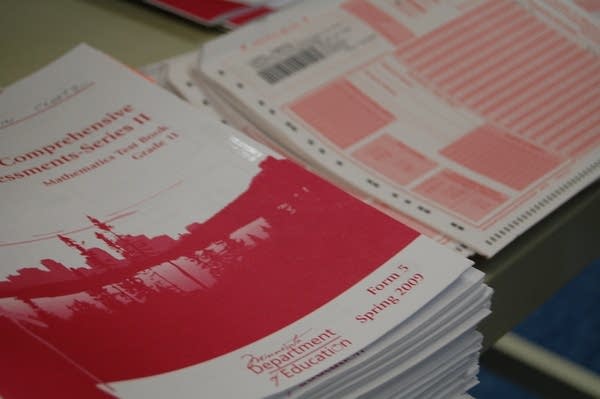Minnesota reading test scores drop; harder tests and standards cited
Go Deeper.
Create an account or log in to save stories.
Like this?
Thanks for liking this story! We have added it to a list of your favorite stories.

At first glance, the results of the latest Minnesota Comprehensive Assessment tests, or MCAs, might take teachers' and parents' breath away.
The percentage of students considered proficient in reading looks like it fell by double digits.
Last year 76 percent of Minnesota students were considered proficient in reading. This year it's about 58 percent.
Among white students it went from 82.5 percent last year to 65 percent this year. African-American students went from 57 percent proficient to 32 percent.
Turn Up Your Support
MPR News helps you turn down the noise and build shared understanding. Turn up your support for this public resource and keep trusted journalism accessible to all.
• Scroll down to read sample test questions for fifth grade reading
• See how your school performed on the tests
The reason? Minnesota Education Commissioner Brenda Cassellius says this is the first year Minnesota 3rd through 8th graders took standardized reading tests based on the Common Core, a new national set of stringent standards intended to better prepare students for college or a career.
"Certainly our kids didn't like all of a sudden take a 20, 30 percent dip in one year in what they know and can do," she said, insisting that it's not appropriate to compare this year's reading scores to last year's.
"These are two completely different tests, kids are asked to do completely different types of tasks on this test, but it's a much more challenging and difficult test."
This year's reading test included more complex language in the passages students were required to read. And it included more questions and harder questions.
"Kids are asked to do completely different types of tasks on this test, but it's a much more challenging and difficult test."
The scores on the new test didn't come as a surprise to schools.
State education officials issued warnings early this summer so the scores wouldn't be perceived as a decline. New York recently released student test scores based on Common Core curriculum with similar warnings, Kentucky did the same last year.
Eric Moore, director of research, evaluation and assessment for Minneapolis Public Schools, is taking the new scores in stride.
Under the new standards, 43 percent of Minneapolis students are considered proficient in reading, 15 points below last year.
"It just gives us a new bar to work towards, so again it's just a baseline for us to move forward on."
Moore says next year's scores in reading will be a key indicator on how students are doing under the new reading standards.
This reset of sorts for student reading scores won't affect how schools rank in the state through the Multiple Measurements Rating, which come out this fall.
That system is based on a slightly different measurement involving grade to grade academic growth.
Moore is happy this year with Minneapolis students' overall math scores -- they're up 3 percentage points over last year.
Statewide however, math proficiency in 3rd through 8th grade declined by a few percentage points over last year, although scores are still higher higher than two years ago.
That quirk may have popped up because in 2012 many districts in the state gave students three MCA math tests and then choose the best one. State officials think that artificially inflated math scores.
The St. Paul district gave students only one math test in 2012, and officials say that's given them solid data this year. It shows students improving in math proficiency by three percentage points over last year.
Matt Mohs, the district's chief academic officer, says just two years ago new tougher state math standards went into place, and St. Paul has been pushing students toward those benchmarks.
"A lot of it has been just intentional focus. So we have particularly been providing more support to schools in math," he said.
The MCAs also measure how well students are doing in science by testing them in 5th and 8th grade and once in high school.
Overall students in 5th and 8th grade improved their proficiency rates by a few percentage points. High school scores went up one point.
State officials say there have been gains in test scores among students of color in recent years but they're not the increases they want to see.
A wide gap of 20 to 30 percentage points still separates white students and students of color in math, science and reading.
Denise Specht, president of the state teachers union Education Minnesota, cautioned parents that test scores aren't always the best indicator of student growth or future success.
"Grades, conferences and even informal talks with teachers all give a better sense of how individual students are learning than these academic snapshots from a few days in April," she said in a statement.
Several Minnesota school districts are currently developing new teacher evaluation systems that take student test scores into account. The union say it embraces the evaluation system, but has been wary of using student test scores as an indicator of teacher's performance.
Specht also raised the question of whether server crashes this spring, that interrupted testing for some 15,000 students, and several snow days at schools in western Minnesota, might have lowered test scores.
Last week the state department of education issued a report that found the computer glitches didn't affect the overall scores of students in this spring round of testing.
Alexandria superintendent Rick Lahn, who closed his district's schools several times last year because of the snowier than usual winter, says that's something they're looking into.
"We can't say with certainty that the number of delays significantly impacted our test scores. I think not, but then again every day we miss puts us a little further behind."
---



